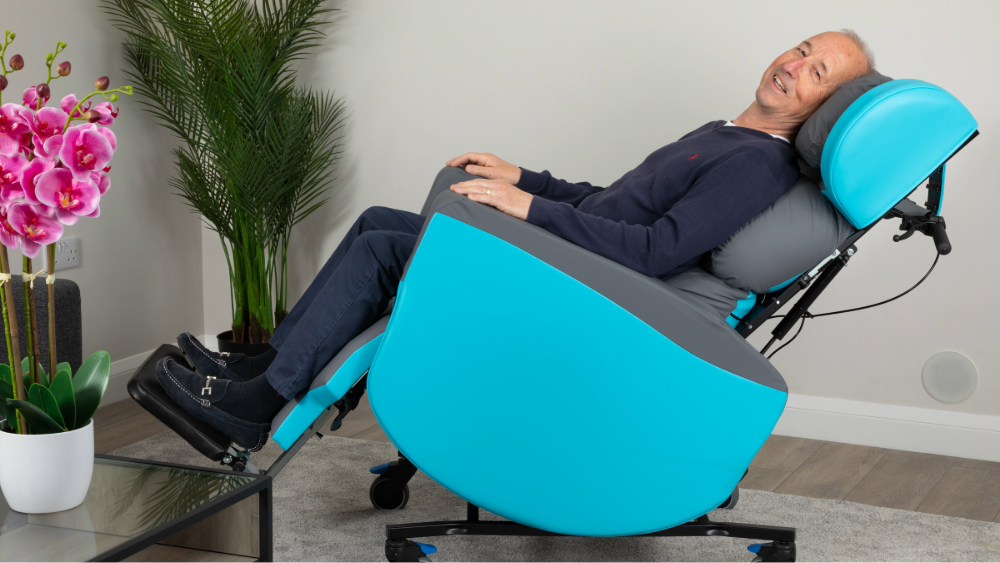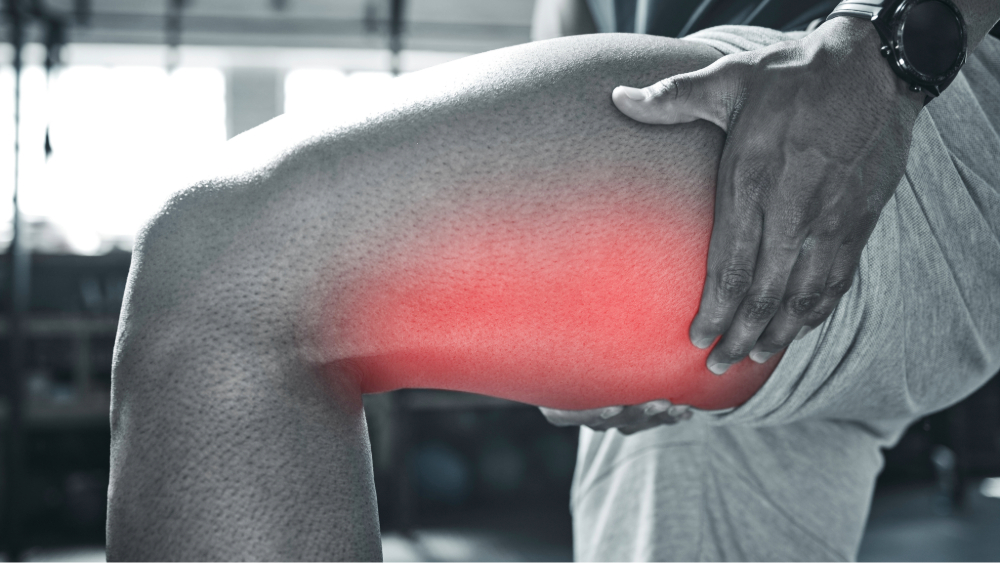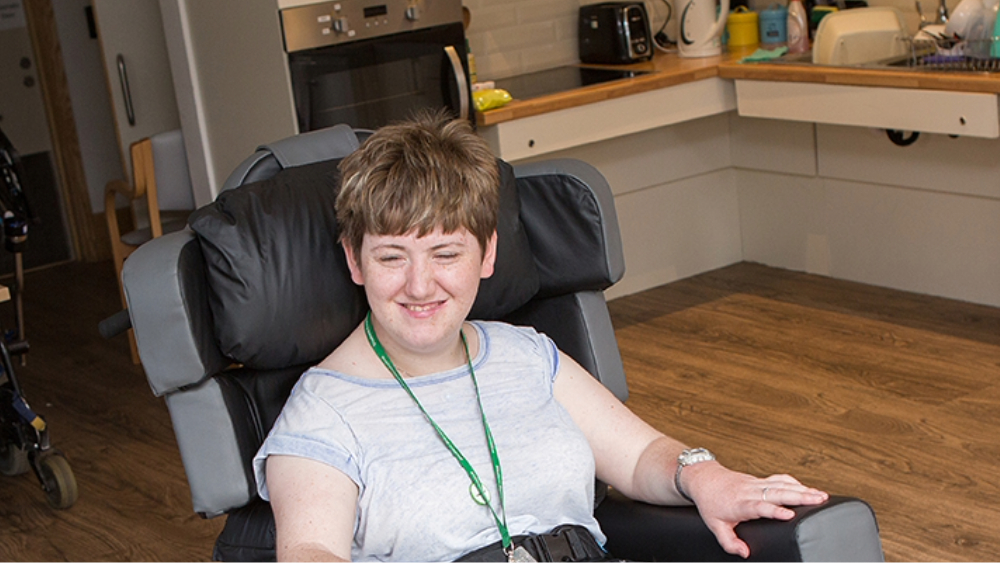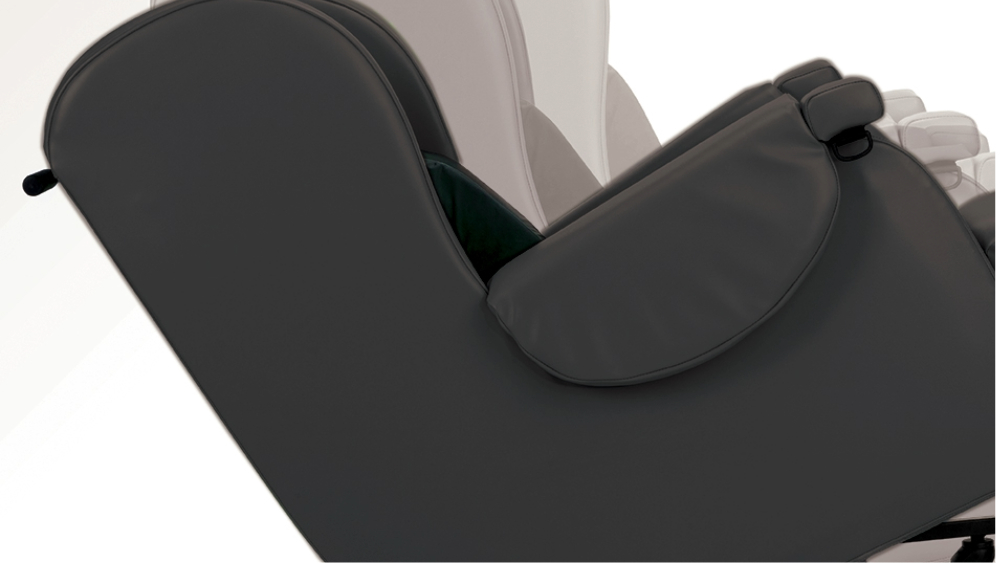At CareFlex, we understand the importance of providing specialist seating that maximises our users’ health and well-being. One of the key features in many of our seating solutions is the Tilt-in-Space (TiS) function. Recently, there has been some debate in the industry about the optimal angle for TiS.
What is Tilt-in-Space?
TiS allows the entire seat and back to tilt posteriorly in unison while maintaining the same angle between them. This differs from the Back Angle Recline (BAR), where the seat-to-back angle adjusts to open the hip angle. TiS is essential for redistributing pressure away from vulnerable areas of the body, such as the ischial tuberosities and sacrum, thereby reducing the risk of pressure ulcers. It also assists with hoisting and positioning by utilising gravity to bring the pelvis down into the back of the chair, reducing the effort required by caregivers. Additionally, TiS helps manage energy levels by allowing an individual to rest in a tilted position before returning upright to continue with activities of daily living.
The 45 Degrees Debate
Some Specialist Seating manufacturers argue that a 45° tilt is essential for effective pressure redistribution. However, our review of the best available evidence suggests that such an extreme angle is not always necessary and can even be counterproductive.
Literature Findings on Tilt Angles
Small angles: A small tilt of up to 15° can be used to adjust pressure distribution through the back.1
Moderate angles: A systematic review concludes that a posterior seat tilt of 20° can effectively reduce interface pressures under the pelvis.2 To be more specific with the data, tilt to 20° results in an 11% reduction in interface pressure.3
Larger angles: Increasing the tilt to 25° doubles the reduction of interface pressure to 22% over the ischial tuberosities.4
Functionality and Comfort in Daily Life
Despite the assumed scientific ideal, individuals with a powered TiS seating function tend to use smaller and medium angles more than large ones;5 individuals spend the greatest amount of time in tilt angles less than 20°.6
The fact that smaller tilt angles are utilised implies that TiS is used more for comfort, stability, and functionality than for shifting weight or pressure management.7 It is well-accepted that comfort is a primary concern during seating provision;8 thus, it is understandable that a chair function, such as TiS, would play a key part in maintaining this comfort level through smaller tilt angles.
While higher tilt angles can offer more pressure relief for those at greatest risk, angles between 20° and 35° can provide a balanced approach, ensuring comfort and functionality. Tilting beyond 35° can negatively impact the chair’s functional use, making it harder for users to engage with their environment and perform daily tasks. Expecting individuals to use such non-functional positions frequently and for long durations is unrealistic9 and may impact tolerance of the seated position and compliance with equipment.
Additionally, beyond 45°, the user’s body weight starts to load through the back surface; however, whilst pressure under the ischial tuberosities reduces, the pressure on the upper part of the pelvis, spine, shoulders, and head all increase—body weight must shift somewhere.
Combining Tilt-in-Space and Back Angle Recline for Optimal Results
Research suggests that TiS and BAR functions are most effective when used in conjunction to achieve optimal pressure care. If BAR is required to adjust the angle between the chair and seat back to accommodate a reduced hip range of movement, then using TiS and BAR in combination can reduce the forces that might otherwise be present when using BAR alone. By using a combination of tilt and recline movements, the pelvis position can be better maintained; this is accomplished by tilting rearward before adjusting the recline angle.
A position of 25° TiS combined with 120° recline is effective in enhancing muscle and skin perfusion of weight-bearing soft tissues at the ischial tuberosities.10
Is Pressure the Only Concern?
Pressure force is not the only factor to be mindful of with regard to pressure injury risk. A pressure ulcer is defined as localised damage to the skin and or underlying tissues because of pressure or pressure in combination with shear.11
In cases where individuals are at greatest risk of shear, the combination of a 110° reclining angle and a 10° TiS angle decreases both the normal and shear force in the gluteal region while sitting.12 Extrapolation of additional data suggests that increasing the tilt to approximately 25° can eliminate shear forces.13
Clinical Application
Individuals with sufficient physical strength and coordination can only perform pressure relief manoeuvres, such as seated push-ups, lateral leaning, and forward leaning. For individuals unable to independently perform these manoeuvres, seating systems with incorporated TiS and BAR offer the ability to redistribute weight and reduce sitting pressures.,14 following a comprehensive assessment of posture and risk*.
As demonstrated, lesser amounts of tilt and recline can be effective in reducing mean sitting interface pressure and shear forces for a balance between health and wellbeing. Considering the difficulty users have incorporating larger angles of tilt and recline into their daily lives and the impact this has on function, the recommendation to perform small angle changes continually throughout the day is likely to be preferred and more widely accepted.15
Please remember that a key intervention for prevention is pressure redistribution17; repositioning is believed to be one of the most effective methods for preventing skin damage.14 Therefore, regardless of the tilt and recline angles indicated, this is of no benefit if the user is not regularly moved through different ranges. Ensuring that an individual’s care plan provides clear guidance on utilising specialist seating and its functions safely and appropriately is critical. Seating solutions must also complement the individual’s other specialist equipment as part of their repositioning programme throughout the full 24-hours.
Be advised that evidence-based practice (EBP) in this clinical field is not as elementary as it appears. Despite the research being available and somewhat generalisable, there are limitations to sample size and specific studies into select client groups. EBP requires that decisions about care are based on the best available, current, valid, and relevant evidence. These decisions should be made by those receiving care, informed by the tacit and explicit knowledge of those providing care, within the context of available resources.16 A Clinician should respect their own autonomy, drawing on their skills and experience to inform decision-making in collaboration with the individual. There will be incidences where a small tilt is indicated; conversely, there will be individuals who require the greatest tilt angles.
Conclusion
Our comprehensive review of the evidence suggests that angles between 20° and 35° are often sufficient for effective pressure care whilst maintaining user comfort and function. At CareFlex, we are committed to providing seating solutions that are both practical and beneficial for our users, with health and well-being at the forefront.
References:
- Aissaoui, R., Lacoste, M., & Dansereau, J. (2001) Analysis of sliding and pressure distribution during a repositioning of persons in a simulator chair Transactions on Neural Systems and Rehabilitation Engineering9(2):215-224
- Michael, S. M., Porter, D., & Pountney, T. E. (2007) Tilted seat position for non-ambulant individuals with neurological and neuromuscular impairment: A systematic review Clinical Rehabilitation 21(12):1063-1074
- Hobson, D. A. (1992) Comparative effects of posture on pressure and shear at the body-seat interface Journal of Rehabilitation Research & Development 29(4):21-31
- Vaisbuch, N., Meyer, S., & Weiss, P. L. (2000) Effect of seated posture on interface pressure in children who are able-bodied and who have myelomeningocele Disability and Rehabilitation 22(17):749-755
- Lacoste, M., Weiss-Lambrou, R., Allard, M., & Dansereau, J. (2003) Powered tilt/recline systems: Why and how are they used? Assistive Technology 15(1):58-68
- Sonenblum, S. E., Sprigle, S., & Maurer, C. (2006) Monitoring power upright and tilt-in-space wheelchair use Poster session presented at: Proceedings of the Rehabilitation Engineering and Assistive Technology Society of North America (RESNA) Conference Atlanta, GA
- Weiss-Lambrou, R., Tremblay, C., LeBlanc, R., Lacoste, M., & Dansereau, J. (1999) Wheelchair seating aids: How satisfied are consumers? Assistive Technology 11(1):43-53
- Bartley, C., Stephens, M. (2017) Evaluating the impact of WaterCell® Technology on pressure redistribution and comfort/discomfort of adults with limited mobility Journal of Tissue Viability 26(2):144-149
- Ding, D., Leister, E., Cooper, R. A., Cooper, R., Kelleher, A., Fitzgerald, SG., Boninger, ML. (2008) Usage of tilt-in-space, recline, and elevation seating functions in the natural environment of wheelchair users Journal of Rehabilitation Research & Development 45(7):973-983
- Jan, Y. K., Crane, B. A., Liao, F., Woods, J. A., & Ennis, W. J. (2013) Comparison of muscle and skin perfusion over the ischial tuberosities in response to wheelchair tilt-in-space and recline angles in people with spinal cord injury Archives of Physical Medicine and Rehabilitation 94(10):1990-1996
- Department of Health. (2022) Pressure ulcers: Applying All Our Health Retrieved from: https://www.gov.uk/government/publications/pressure-ulcers-applying-all-our-health/pressure-ulcers-applying-all-our-health [Accessed 25th May 2024]
- Koda, H., Okada, Y., Fukumoto, T., & Morioka, S. (2022) Effect of tilt-in-space and reclining angles of wheelchairs on normal force and shear force in the gluteal region International Journal of Environmental Research and Public Health 19(9):5299
- Hobson, D. A. (1992) Comparative effects of posture on pressure and shear at the body-seat interface Journal of Rehabilitation Research & Development 29(4):21-31
- Sprigle, S., & Sonenblum, S. (2011) Assessing evidence supporting redistribution of pressure for pressure ulcer prevention: A review Journal of Rehabilitation Research & Development 48(3):203-213
- Zemp, R., Rhiner, J., Plüss, S., Togni, R., Plock, JA., Taylor, WR. (2019) Wheelchair tilt-in-space and recline functions: Influence on sitting interface pressure and ischial blood flow in an elderly population BioMed Research International 4027976
- Dawes, M., Summerskill, W., Glasziou, P., Cartabellotta, A., Martin, J., Hopayian, K., Porzsolt, F., Burls, A., & Osborne, J. (2005) Sicily statement on evidence-based practice BMC Medical Education 5(1):1-7
- (2017) Pressure ulcers (pressure sores) Retrieved from: https://www.nhs.uk/conditions/pressure-sores/treatment/ [Accessed 25th May 2024]
*Tilt-in-Space and Back Angle Recline functions should always be prescribed responsibly, ensuring that it is safe and appropriate for the user following a comprehensive assessment of posture and risk, with advice sought from the multi-disciplinary team where indicated. In some cases, these functions will be contra-indicated, and could also increase pressure, shear, and friction forces.



